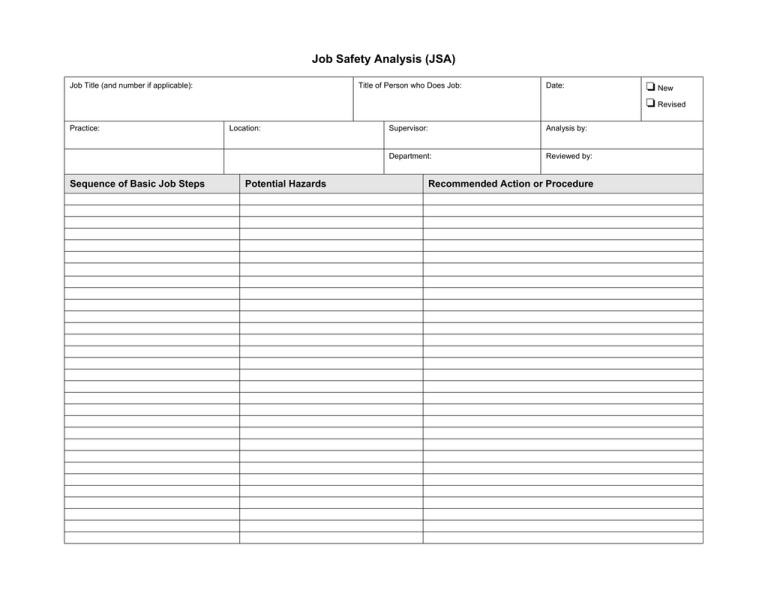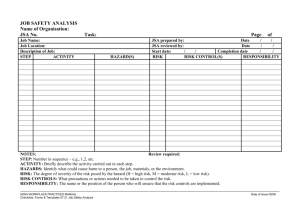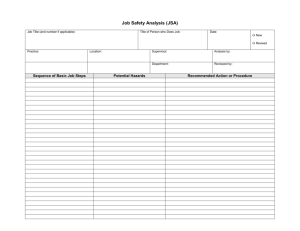Job Hazard Analysis
advertisement

Job Safety Analysis (JSA) Job Title (and number if applicable): Practice: Sequence of Basic Job Steps Title of Person who Does Job: Location: Potential Hazards Date: Supervisor: Analysis by: Department: Reviewed by: Recommended Action or Procedure New Revised Instructions for Completing a JSA Form A Job Safety Analysis (JSA) is an important accident prevention tool that works by finding hazards and eliminating or minimizing them before the job is performed and before the employee has a chance to become injured. Use your JSA for job clarification and hazard awareness; as a guide in new employee training, periodic contacts, retraining senior employees, and as a refresher for infrequent jobs; as an accident investigation tool; and for informing employees of specific job hazards and protective measures. Here’s how to complete each of the three JSA parts. Sequence of Basic Job Steps Potential Hazards Recommended Action or Procedure Break the job down into steps. Each job step should accomplish some major task. The task will consist of a set of movements. Look at the first set of movements used to perform a task and determine the next logical set of movements. For example, the job might be to move a box from a receiving area to a shelf in a storage area. How does that break down into job steps? Picking up the box and placing it on a hand truck is one logical set of movements, so it is one job step. Everything related to that one logical set of movements is part of that job step. Identify the hazards associated with each step. Examine each step to find and identify hazards, actions, conditions, and possibilities that could lead to an accident. Using the first two columns as a guide, decide what actions are necessary to eliminate or minimize the hazards that could lead to an accident, injury, or occupational illness. The next logical set of movements might be pushing the loaded hand truck to the storeroom. Removing the boxes from the truck and placing them on the shelf is another logical set of movements. And finally returning the hand truck to the receiving area might be the final step in this type of job. It is important to list all hazards. Hazards contribute to accidents, injuries, and occupational illnesses. Be sure to list all the steps in a job. Some steps might not be done each time, such as checking the casters on the hand truck. Hazard: A potential danger. Oil on the floor is a hazard. It’s not enough to look at the obvious hazards. It’s also important to look at the entire environment and discover every conceivable hazard that might exist. Be sure to list health hazards, even though the harmful effect may not be immediate. A good example is the harmful effect of inhaling a solvent or chemical dust over a long period of time. In order to do part three of a JSA effectively, you must identify potential and existing hazards. That’s why it is important to distinguish between a hazard, an accident, and an injury. Each of these items has a specific meaning. Accident: An unintended happening that may result in injury, loss, or damage. Slipping on the oil is an accident. Injury: The result of an accident. A sprained wrist from the fall would be an injury. Some people find it easier to identify possible accidents and illnesses and work back from them to the hazards. If you do that you can list the accident and illness types in parentheses following the hazard. Be sure you focus on the hazard for developing recommended actions and safe work procedures. Among the actions that can be taken are: 1) engineering the hazard out 2) providing personal protective equipment (PPE) 3) job instruction training 4) good housekeeping 5) good ergonomic techniques List recommended safe procedures on the form and also list required or recommended PPE for each step of the job. Be specific. Say exactly what needs to be done to correct the hazard, such as lift using your leg muscles. Avoid general statements like ‘be careful’. Give a recommended action or procedure for every hazard. If the hazard is serious, it should be corrected immediately. The JSA should then be changed to reflect the new conditions.




